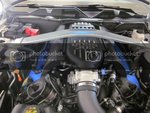Thinking about getting an oil separator on the passenger side... Was wondering if anyone had any opinions about JLT versus Moroso...The Moroso looks more durable and I like the fact that is has all metal fittings. Looks like you might run into less problems with it breaking... Any thoughts? (I know the Moroso is a little more expensive, but I'd rather pay a little more if it's going to last longer. I heard though that I might need to replace those"heater hoses" as they're not really designed to withstand oil)
- Welcome to the Ford Mustang forum built for owners of the Mustang GT350, BOSS 302, GT500, and all other S550, S197, SN95, Fox Body and older Mustangs set up for open track days, road racing, and/or autocross. Join our forum, interact with others, share your build, and help us strengthen this community!
You are using an out of date browser. It may not display this or other websites correctly.
You should upgrade or use an alternative browser.
You should upgrade or use an alternative browser.
Different Oil Separator Installations
- Thread starter808Boss
- Start date
This site may earn a commission from merchant affiliate links, including eBay, Amazon, and others.
More options
Who Replied?NFSBOSS said:One item, do you need 2 or 4 hose clamps?
You need four hose clamps. In my version, two are factory-style crimp clamps and two are hose-end style (Fragola brand). Both were chosen for their appearance. For a budget install, one could use four ordinary hose clamps that cost less than a buck apiece.
Jimmy
Gotcha, I thought you were using four of the Fragola clamps (that's what I have on my setup) but I see from the photo below that the swivel seals have a similar looking fitting.
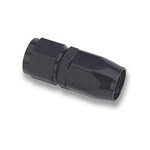
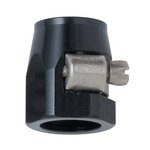
How long is each piece of hose? I'm looking to reuse some of the pieces I have on my Steeda oil separator and don't want to purchase pieces I already have.
Also do you think cable ties would work just as well instead of hose clamps for the two caps? They might be cleaner looking.


How long is each piece of hose? I'm looking to reuse some of the pieces I have on my Steeda oil separator and don't want to purchase pieces I already have.
Also do you think cable ties would work just as well instead of hose clamps for the two caps? They might be cleaner looking.
Oh great. So I'm trying to buy the Peterson can and it looks like they've had a big price increase. It now retails for $200 and the cheapest I can find it is for about $158 delivered. Does anyone know where to find it for less?
http://www.ebay.com/itm/Peterson-Remote-Breather-Can-Peterson-Spun-Aluminum-2-Ea-12-AN-Female-Ports-/400337980966?pt=Race_Car_Parts&hash=item5d3600ce26&vxp=mtr
http://www.ebay.com/itm/Peterson-Remote-Breather-Can-Peterson-Spun-Aluminum-2-Ea-12-AN-Female-Ports-/400337980966?pt=Race_Car_Parts&hash=item5d3600ce26&vxp=mtr
NFSBOSS said:Gotcha, I thought you were using four of the Fragola clamps (that's what I have on my setup) but I see from the photo below that the swivel seals have a similar looking fitting.
Yes, by design.
NFSBOSS said:How long is each piece of hose? I'm looking to reuse some of the pieces I have on my Steeda oil separator and don't want to purchase pieces I already have.
With ends on them it is hard to be ultra precise, but:
322 mm
824 mm
Obviously, this is determined by where the catch can is mounted so YMMV!
NFSBOSS said:Also do you think cable ties would work just as well instead of hose clamps for the two caps? They might be cleaner looking.
Absolutely. The caps fit snugly and are under vacuum, so they aren't going anywhere. Cable ties would work just fine.
Speaking of budget builds, what the hell happened to the price of that can? I bought mine On Dec. 28 from the same Amazon source that I linked to and it was $90. Not much point in talking about saving by using budget hose, fittings, and clamps, if the catch can is 200 bones.
Jimmy
Thanks. I think I'll go this route although it's not much cheaper. I already have four Fragola clamps so I'm set there. Is the the correct one?Jimmy Pribble said:Yes, by design.That brings up a tip for guys who don't want to build hoses with proper ends. It's not rocket science to build them, but you really need a vise and it is helpful to have vise inserts designed for building hoses with fittings. Instead, you can substitute Earl's Auto-Mate ends (cheaper, too), which require a hose clamp and then use a Fragola clamp to make it look like a proper hose end. For budget builds, skip the Fragola and again you can use an ordinary hose clamp.
http://www.summitracing.com/parts/ear-at700110erl/overview/
NFSBOSS said:Thanks. I think I'll go this route although it's not much cheaper. I already have four Fragola clamps so I'm set there. Is the the correct one?
http://www.summitracing.com/parts/ear-at700110erl/overview/
Yes. In fact, I can tell you that I accidentally ordered those ends (also from Summit) first, not realizing it wasn't what I wanted. So, I have test fit those fittings with the Fragola and it looks great. I would send you a photo, but I left my extra hose at the shop. I promise that it looks terrific and will work great.
Thanks!Jimmy Pribble said:Yes. In fact, I can tell you that I accidentally ordered those ends (also from Summit) first, not realizing it wasn't what I wanted. So, I have test fit those fittings with the Fragola and it looks great. I would send you a photo, but I left my extra hose at the shop. I promise that it looks terrific and will work great.
JTRATX said:Here is a pic of my finished catch can.
I used the Moroso one and took out the passenger PCV and replaced with the same tube from the driver side. Removing PCV did zero to the car.
Unless you like to spend a lot of $$ on AN fittings and braided hoses, standard 1/2" fuel hose does the trick too.
When I first used an oil separator, I broke out the PCV and reattached everything. I found out the car would blow smoke at startup. You have plugged off the intake, I did not, still I wonder how this will act since your can is not vented. What you have done is equal to just running a hose from one side to the other. There is a reason for the venting of this system but I am not sure I would be able to explain it correctly so I will leave that to someone that might be able to do so.
- 110
- 0
With the price increase it would seem that they either stopped making the Peterson can or there has been a supply disruption. If somone wanted to go this route would this be a solid alternative, also from Peterson? http://www.amazon.com/Peterson-Systems-08-0410-Breather-Fittings/dp/B003M8M4VU
2012YellowBoss said:When I first used an oil separator, I broke out the PCV and reattached everything. I found out the car would blow smoke at startup. You have plugged off the intake, I did not, still I wonder how this will act since your can is not vented. What you have done is equal to just running a hose from one side to the other. There is a reason for the venting of this system but I am not sure I would be able to explain it correctly so I will leave that to someone that might be able to do so.
My set up isn't any different from post 119, his isn't vented, nor is the pics of the 302S a few posts before that. So far the car idles and runs exactly the same.
JTRATX said:My set up isn't any different from post 119, his isn't vented, nor is the pics of the 302S a few posts before that. So far the car idles and runs exactly the same.
The Peterson (302S) is a vented breather can. I will try to post pictures tonight and I will also revise my article to call it a breather can throughout. I kept calling it a catch can, which isn't fully correct.
Jimmy Pribble said:The Peterson (302S) is a vented breather can. I will try to post pictures tonight and I will also revise my article to call it a breather can throughout. I kept calling it a catch can, which isn't fully correct.
JTRATX, Jimmy is correct, that can is vented. From what I understand that is the whole point here, venting the system rather then buring off what is in there. At the very least I still think you may see smoke at startup which could cause problems like fouling the plugs. I am not wishing you bad just telling what happened to me when I first experimented with this. The big difference being I still had it hooked up to my intake. If one of our expert engine/emissions guys don't come along to explain this better I would talk this over with someone you trust at a local shop.
2012YellowBoss said:JTRATX, Jimmy is correct, that can is vented. From what I understand that is the whole point here, venting the system rather then buring off what is in there. At the very least I still think you may see smoke at startup which could cause problems like fouling the plugs. I am not wishing you bad just telling what happened to me when I first experimented with this. The big difference being I still had it hooked up to my intake. If one of our expert engine/emissions guys don't come along to explain this better I would talk this over with someone you trust at a local shop.
Hmmmm, interesting points. I'm no emissions guy either, but I'm now wondering what the difference is between my set up and having it set up like OEM W/o the catch can. In both instances they are re circulating back into the engine.
I looked at start up this morning and didn't have any smoke, but that's not to say it couldn't start, and I've only ran 150 miles w the catch can.
Did you remove the PVC valve?JTRATX said:Hmmmm, interesting points. I'm no emissions guy either, but I'm now wondering what the difference is between my set up and having it set up like OEM W/o the catch can. In both instances they are re circulating back into the engine.
I looked at start up this morning and didn't have any smoke, but that's not to say it couldn't start, and I've only ran 150 miles w the catch can.
JTRATX said:Hmmmm, interesting points. I'm no emissions guy either, but I'm now wondering what the difference is between my set up and having it set up like OEM W/o the catch can. In both instances they are re circulating back into the engine.
I looked at start up this morning and didn't have any smoke, but that's not to say it couldn't start, and I've only ran 150 miles w the catch can.
your setup will increase the pressure within the head over time, which is not a good thing. i highly recommend you re-route your lines, or drill a hole in your catch-can and place a breather filter.
I am not sure about my earlier statement about fouling the plugs. I do not know how trapped gasses will effect them, while it is possible I am not certain. Please take the time to read this
http://en.wikipedia.org/wiki/Crankcase_ventilation_system
There are other sources out there with good info. Since I am not an expert I did not want to go to far into this - better to thought of as a fool then open your mouth and remove all doubt - but if the info on Wiki is correct you can gain a few points from it. At the very least you will get a build up of sludge, possible oil leaks (not sure how much on these newer engines) and if the info is correct and the gasses that build up are in fact toxic (and flammable!) it could hurt/corrode engine parts to name a few.
In some ways the 302S system can leave us open to the same problems but at a lower rate since it is a vent but does not evacuate the system under pressure (vacuum). However I would rather take my chances then run the vast amount of blow-by oil theses car produce into my intake. I am sure that the amount of blow-by is increased by RPM and people that track these cars are running 5k or more most of the time. My car would use a quart of oil per day on track, it has since calmed down.
Like I said what you have done is equal to simply running a hose from one side to the other, having the can in there dose nothing and I doubt you will even see much oil captured in it. Even if it does it would not make a difference since you are not stopping it from entering the intake, you just capture what would be transferred between heads. I would recommend you modifying this system, I may not be an expert here but you have to ask yourself why the race teams would add the breather can into the system then just run a hose from one side to the other.
The difference is you remove the vacuum source (intake tube - right side), the clean air to flush the engine (intake air tube - left side) that are used to evacuate the gasses. So you are no longer circulating the gasses to be burned off. You are just trapping the gasses, oil, etc. forever or until they find a weak point to leak out. The PVC does not "recirculate" gasses, it eventually burn them off. This is a major difference.
http://en.wikipedia.org/wiki/Crankcase_ventilation_system
There are other sources out there with good info. Since I am not an expert I did not want to go to far into this - better to thought of as a fool then open your mouth and remove all doubt - but if the info on Wiki is correct you can gain a few points from it. At the very least you will get a build up of sludge, possible oil leaks (not sure how much on these newer engines) and if the info is correct and the gasses that build up are in fact toxic (and flammable!) it could hurt/corrode engine parts to name a few.
In some ways the 302S system can leave us open to the same problems but at a lower rate since it is a vent but does not evacuate the system under pressure (vacuum). However I would rather take my chances then run the vast amount of blow-by oil theses car produce into my intake. I am sure that the amount of blow-by is increased by RPM and people that track these cars are running 5k or more most of the time. My car would use a quart of oil per day on track, it has since calmed down.
Like I said what you have done is equal to simply running a hose from one side to the other, having the can in there dose nothing and I doubt you will even see much oil captured in it. Even if it does it would not make a difference since you are not stopping it from entering the intake, you just capture what would be transferred between heads. I would recommend you modifying this system, I may not be an expert here but you have to ask yourself why the race teams would add the breather can into the system then just run a hose from one side to the other.
JTRATX said:Hmmmm, interesting points. I'm no emissions guy either, but I'm now wondering what the difference is between my set up and having it set up like OEM W/o the catch can. In both instances they are re circulating back into the engine.
The difference is you remove the vacuum source (intake tube - right side), the clean air to flush the engine (intake air tube - left side) that are used to evacuate the gasses. So you are no longer circulating the gasses to be burned off. You are just trapping the gasses, oil, etc. forever or until they find a weak point to leak out. The PVC does not "recirculate" gasses, it eventually burn them off. This is a major difference.
NFSBOSS said:Did you remove the PVC valve?
I did remove the PCV. I was trying to emulate the 302S set up which by the look at the picture I did. Unfortunately the 302S picture doesn't look like it's vented, which apparently it is and I understand why it needs to be vented.
So now I need to either re route mine, or drill and tap a vent into it.
- 159
- 0
You have to vent it somewhere or you will have problems...blown seals for sure. I've had vacuum pumps fail and it's not pretty!! My new drag car has 1 gallon tank and a 4in hole in the top for a breather...probably going to use a K&N on it...Like a Mustang conical filter.
Okay, here are some additional notes and details about the Peterson breather can.
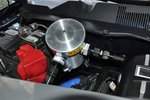
Unless you want to cut your firewall for clearance, this is the 'service position.' Undoing the 11 mm nut on the band clamp allows the can to be pulled forward, clear of the firewall. To remove the cap for servicing, loosen the 11 mm nut on top. Once it is just broken loose, unscrew the whole cap to remove. THE NUT, THE CAP, AND THE THREADED ROD ARE CONNECTED. In fact, all of the guts are connected to the threaded rod (see photo 3). Once the cap and filter are removed, oil can be removed with a turkey baster or whatever.
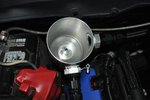
At the bottom of the breather can, there is a tapped bung that holds the threaded post. The bung is stitch welded to the can in a way that allows oil to flow beneath it and into a tapped drain, which is the other way to service the breather can. What you can't see...is any oil. After five days of ordinary driving and one 15 minute track session, there is not a single drop of oil in the can. I will continue to monitor the rate that oil is captured by this system.
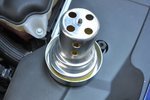
Here you can see the end of the threaded rod that screws into the bottom of the can. There is an internal baffle, within which is a foam filter. The threaded rod also spaces the cap away from the baffle and the sides of the can, so that it does not seal and is a vented system.
Besides a better of understanding of how this breather can works, you can also see some of the reasons that this breather can might initially seem overly expensive, until you see the quality of construction and the hidden details.
Jimmy

Unless you want to cut your firewall for clearance, this is the 'service position.' Undoing the 11 mm nut on the band clamp allows the can to be pulled forward, clear of the firewall. To remove the cap for servicing, loosen the 11 mm nut on top. Once it is just broken loose, unscrew the whole cap to remove. THE NUT, THE CAP, AND THE THREADED ROD ARE CONNECTED. In fact, all of the guts are connected to the threaded rod (see photo 3). Once the cap and filter are removed, oil can be removed with a turkey baster or whatever.

At the bottom of the breather can, there is a tapped bung that holds the threaded post. The bung is stitch welded to the can in a way that allows oil to flow beneath it and into a tapped drain, which is the other way to service the breather can. What you can't see...is any oil. After five days of ordinary driving and one 15 minute track session, there is not a single drop of oil in the can. I will continue to monitor the rate that oil is captured by this system.

Here you can see the end of the threaded rod that screws into the bottom of the can. There is an internal baffle, within which is a foam filter. The threaded rod also spaces the cap away from the baffle and the sides of the can, so that it does not seal and is a vented system.
Besides a better of understanding of how this breather can works, you can also see some of the reasons that this breather can might initially seem overly expensive, until you see the quality of construction and the hidden details.
Jimmy
